
Home
Services
About us
Blog
Contacts
Industrial IoT Solutions: Architecting Rugged, Data-Driven Operations With A-Bots.com
1.From Field Sensors to Cloud and Back: The End-to-End Industrial IoT Stack
2.Data Gravity in the Factory: Streaming Analytics, AI Models and Closed-Loop Control
3.Securing the Harsh Edge: Cyber-Physical Threats, Compliance and Zero-Trust Architectures
4.Build-to-Scale With A-Bots.com: Engagement Models, Tech Stack Choices and Go-Live Blueprint
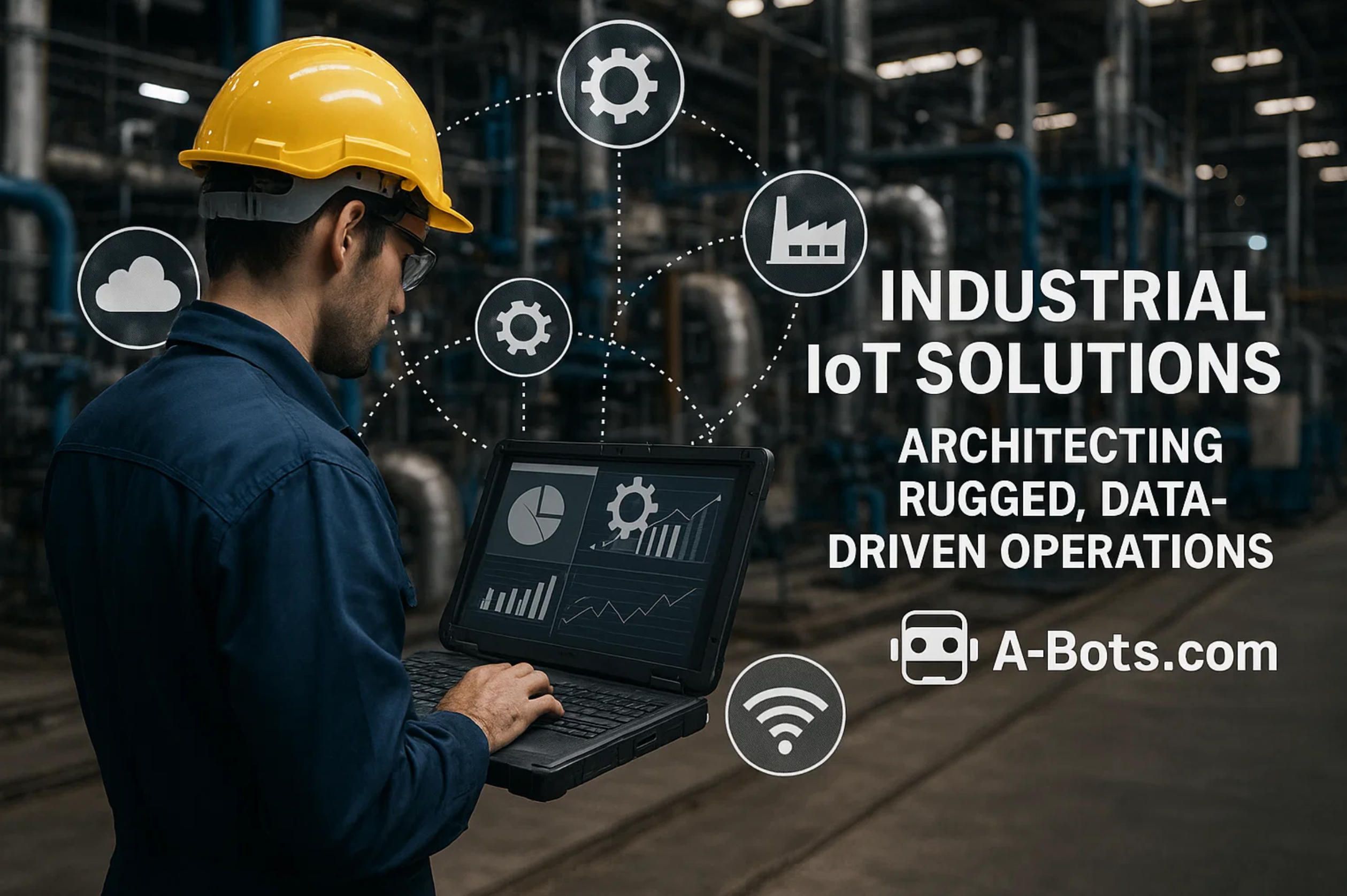
1.From Field Sensors to Cloud and Back: The End-to-End Industrial IoT Stack
Modern factories, refineries, and mining sites survive on millisecond decisions, and only industrial IoT solutions that sense, decide, and act within that narrow window can turn raw telemetry into profit. At A-Bots.com we architect industrial IoT solutions that treat every bolt as a data publisher and every kilobyte as a decision trigger, blending harsh-environment electronics with cloud-native elasticity. Analysts put the core market for industrial IoT solutions at more than 77 billion USD in 2025, on track to quintuple within a decade, proving that industrial IoT solutions have moved from experiment to operational backbone.
1.1 Rugged Sensing: Where Data Gravity Begins
Reliable physics capture is the foundation of all industrial IoT solutions. Our modular sensor nodes wrap low-power ARM microcontrollers in IP67 aluminium, carry redundant power rails, and hold calibration from −40 °C to +85 °C. On brown-field retrofits we preserve Modbus RTU/TCP because that protocol still dominates legacy PLC backplanes and will stay relevant well past 2030. Green-field projects leapfrog to an OPC UA plus MQTT fabric, so industrial IoT solutions can auto-discover tags, publish rich metadata, and slash wiring overhead through true publish/subscribe semantics.
Bandwidth sizing is deliberate. Required throughput equals the sum over every sensor of its sampling rate multiplied by bits per sample. When the calculated load climbs beyond sixty per cent of physical capacity we split deterministic control traffic from analytics traffic, guaranteeing that real-time layers inside industrial IoT solutions stay free of burst storms.
1.2 Edge Gateways: Turning Millivolts into Telemetry
Sensors whisper in millivolts, but supervisors need Overall Equipment Effectiveness on a phone screen. Rugged edge gateways—fanless x86 or quad-core ARM boxes with TPM 2.0 chips and conformal coating—perform that semantic lift-off. Global gateway revenue is projected to rise from 2.5 billion USD in 2024 to about 8 billion USD by 2033, mirroring how compute migrates to the shop floor to energize latency-critical industrial IoT solutions.
Inside each gateway our industrial IoT solutions run lightweight K3s clusters that orchestrate three container roles. First, a protocol concentrator bridges Modbus, ProfiNet, and CANopen into Sparkplug-B MQTT so old PLC tags become first-class citizens of new industrial IoT solutions. Second, a stream pre-processor executes two-second tumbling windows, computes statistical moments, and applies delta-of-delta compression that shrinks payloads by roughly eighty per cent. Third, an AI inference pod uses ARM-NN or TensorRT to score anomalies right beside the machine, so industrial IoT solutions can react before the cloud even wakes up.
Security is non-negotiable. Every boot sequence validates a signed image, secrets rotate automatically, and gateways satisfy IEC 62443-4-2 secure-boot rules. These safeguards ensure that industrial IoT solutions are resilient to firmware tampering and credential theft even in hostile network segments.
1.3 Cloud Brokers and Microservices: Telemetry to Decision
When edge-refined data crosses the Demilitarized Zone it lands in an event hub—AWS IoT Core, Azure IoT Hub, or a self-hosted EMQX cluster—where each topic is labeled by plant, line, and asset. From there our industrial IoT solutions fan streams into specialized microservices. Time-series databases such as InfluxDB and TimescaleDB absorb millions of points per minute without losing cardinality. Streaming analytics engines like Apache Flink and Kinesis Analytics detect complex-event patterns—RMS surges, covariance shifts—and fire alerts back to the edge within half a second. TorchServe or Triton hosts machine-learning models that forecast remaining useful life, energy drift, or impending quality deviations, while Kubeflow rolls new models out with blue-green tactics so industrial IoT solutions keep learning without downtime.
Elastic scale, multi-availability-zone redundancy, and fine-grained IAM policies keep telemetry sovereign yet instantly shareable across a fleet of industrial IoT solutions. Because compute gravitates toward data, some inference workloads still remain at the edge, but the cloud orchestrates fleet comparison and long-horizon optimization, proving that balanced architectures make industrial IoT solutions both fast and future-proof.
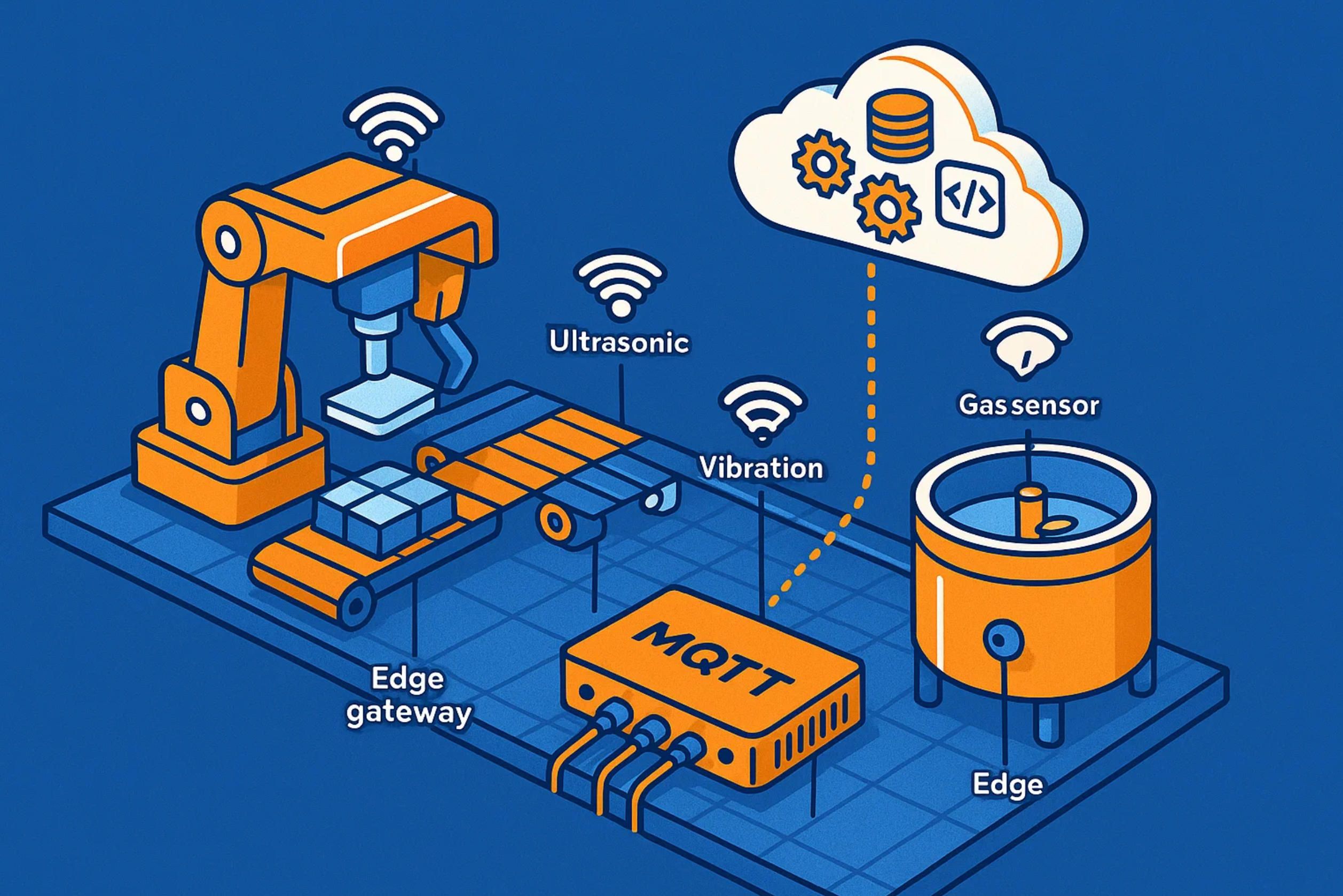
1.4 Closing the Loop: From Insight to Actuation
Analytics that never actuates is just storage. Our industrial IoT solutions push prescriptive commands back to drives, valves, and robots via OPC UA Methods or mutually authenticated REST calls, completing the digital reflex arc. Common actions include trimming spindle speed when chatter peaks, enabling energy-saver mode on partial loads, or rewriting PID coefficients before cavitation begins. Because every control packet is signed and time-stamped, industrial IoT solutions maintain traceable provenance and withstand rigorous audits.
Flutter-built mobile HMIs subscribe to filtered MQTT topics so technicians receive actionable alerts in under two hundred milliseconds. Offline packets cache locally and synchronize once coverage returns, ensuring that industrial IoT solutions remain operator-first even in radio-frequency dead zones. A zero-trust envelope—least-privilege tokens, certificate pinning, and signed protobuf payloads—prevents adversaries from hijacking the actuation channel that drives industrial IoT solutions.
1.5 Why A-Bots.com for Next-Generation Industrial IoT Solutions
Designing durable, deterministic, and future-proof industrial IoT solutions is a marathon of trade-offs: physics versus firmware, latency versus analytics depth, open standards versus vendor lock-in. A-Bots.com has shipped more than forty industrial IoT solutions across metallurgy, food processing, renewables, and logistics, from chromium-plating lines in Germany to solar-farm combiner boxes in Arizona and high-altitude conveyors in Kazakhstan. Our engineers write Rust, Go, and Kotlin as fluently as they tune PID loops, giving your team one partner who speaks both operational technology and cloud. A-Bots.com offers IoT Application Development Services.
Whether you need a one-week discovery sprint or a multi-site rollout, we blueprint, prototype, and harden industrial IoT solutions that stay reliable for decades yet update like SaaS. If you are ready to turn sensor noise into real-time action, let us build resilient, data-driven industrial IoT solutions together.
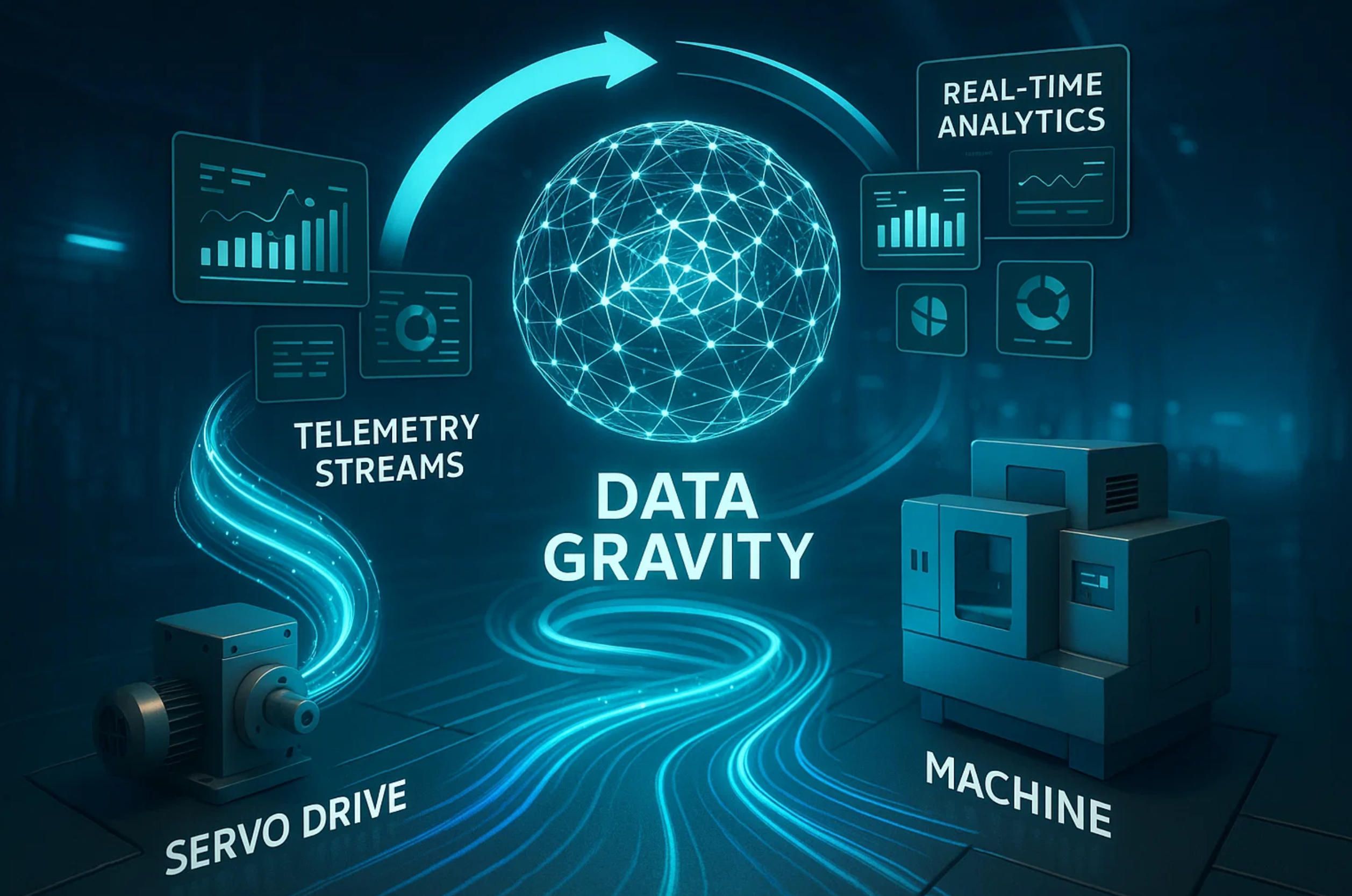
2.Data Gravity in the Factory: Streaming Analytics, AI Models and Closed-Loop Control
Data is heavy. Once it starts flowing inside a plant, it pulls compute, storage and decision-making toward itself. That “data gravity” principle underlies all industrial IoT solutions. The bigger the gravity well, the closer every algorithm has to orbit if industrial IoT solutions want sub-second insight. A-Bots.com treats the principle like a law of physics: if the round-trip from sensor to action exceeds one second, the opportunity window for quality, safety or energy savings is already closing. The paragraphs below show how streaming backbones, edge feature engineering, AI ensembles and reflex-arc feedback keep industrial IoT solutions inside that one-second budget.
2.1 Streaming backbones: ingest once, compute everywhere
Every spindle-motor vibration and boiler-pressure spike is born as a millisecond event; industrial IoT solutions therefore start with a unified streaming layer. Manufacturers surveyed in 2025 report that MQTT brokers paired with a Unified Namespace have become the default pattern for future-proof industrial IoT solutions, because one topic hierarchy can feed ERP, MES and AI simultaneously hivemq.com. Apache Kafka or HiveMQ handles the burst pressure; sizing rules are ruthless. Service rate must exceed event rate multiplied by the expected burst factor and divided by a seventy-per-cent utilisation ceiling. That formula forces architects of industrial IoT solutions to provision partitions for Black-Friday-scale surges, not sunny-day averages. If a gateway detects overload, it spins up a side-car broker so industrial IoT solutions stay loss-free even while firmware updates roll across the line.
2.2 Edge feature engineering: compute follows data gravity
Markets & Markets projects the industrial edge market will jump from twenty-one billion USD in 2025 to nearly forty-five billion USD by 2030, a sixteen-per-cent CAGR that mirrors compute chasing data gravity inside industrial IoT solutions MarketsandMarkets. Fanless gateways now pack quad-core ARM A55 chips and TPU co-processors. Inside those boxes, A-Bots.com deploys Apache Flink jobs that slice two-second tumbling windows, calculate sixty-three statistical moments and publish an “anomaly probability” metric. Delta-of-delta compression removes eighty per cent of bytes yet keeps the nuance industrial IoT solutions need for accurate prediction. Because compute lives on-prem, operators see red-line deviations in under two-hundred milliseconds—even if the campus link to the cloud hiccups. Industrial IoT solutions thus marry enterprise-grade analytics with PLC-grade determinism.
2.3 AI ensembles: from predictive to prescriptive
Unplanned downtime still vaporises about 1.4 trillion USD a year, or eleven per cent of revenue for the world’s top manufacturers ismworld.org. That giant pain point pushes industrial IoT solutions beyond dashboards into machine-learning. A-Bots.com maintains model “zoos” where every plant trains sibling networks: one on fleet-wide data that captures global patterns, the other on local idiosyncrasies. The ensemble fuse is a weighted sum—global output times beta-g plus local output times beta-l, with betas summing to one—so industrial IoT solutions can pivot toward fresh local behaviour after a retrofit. Remaining-useful-life regressors drive just-in-time maintenance; quality classifiers cut scrap before it happens. The next frontier is prescriptive control: reinforcement agents run in physics-based simulators, learn safe policies, and then propose minimal-risk set-point tweaks. Because training remains off-line, industrial IoT solutions safeguard live production while still converging on optimum control curves.
2.4 Closed-loop reflex arcs: insight that acts
Analytics without actuation is just a cost centre. Industrial IoT solutions close the loop by writing new PID coefficients, derating drives or opening valve trims directly over OPC UA Methods or signed REST calls. A peer-reviewed IET study on oil-field optimisation logged a six-per-cent lift in recovery factor after deploying closed-loop industrial IoT solutions that tuned gas-lift rates every fifteen minutes. Flutter mobile HMIs extend the arc to people: technicians receive WebSocket alerts in under two-hundred milliseconds, swipe to acknowledge, and pull cached Grafana traces even offline. Mutual TLS, certificate pinning and TPM-anchored keys prevent hijacking of the actuation channel, a mandatory guardrail as industrial IoT solutions multiply across heterogeneous networks.
2.5 Blueprint: turning data gravity into business gravity with A-Bots.com
IMARC expects the wider industrial IoT solutions market to rocket past 847 billion USD by 2033 on a 12.7 per-cent CAGR imarcgroup.com. Yet technology alone is not enough; disciplined playbooks turn terabytes into dollars. A-Bots.com follows four stages. First comes a sensor-to-edge audit that maps hot-spots of data gravity across the line. Second, a four-week streaming proof of concept uses open-source backbones so clients own every byte. Third, dual-stack AI brings cloud-grade perspective and edge-grade speed. Fourth, a phased roll-out starts with one cell and scales plant-wide, ensuring industrial IoT solutions mature without factory-wide shocks.
A-Bots.com has shipped more than forty industrial IoT solutions across metals, food and renewables. Our engineers write Rust and Kotlin as fluently as they tune PID loops, giving your OT team a single partner who speaks both ladder logic and Kubernetes. Whether you need a rapid anomaly-detection pilot or a multi-site prescriptive-control deployment, we can prototype and harden industrial IoT solutions that respect data gravity, protect uptime and pay for themselves in months. Let’s convert your sensor deluge into real-time business advantage with resilient, vendor-neutral industrial IoT solutions engineered by A-Bots.com.
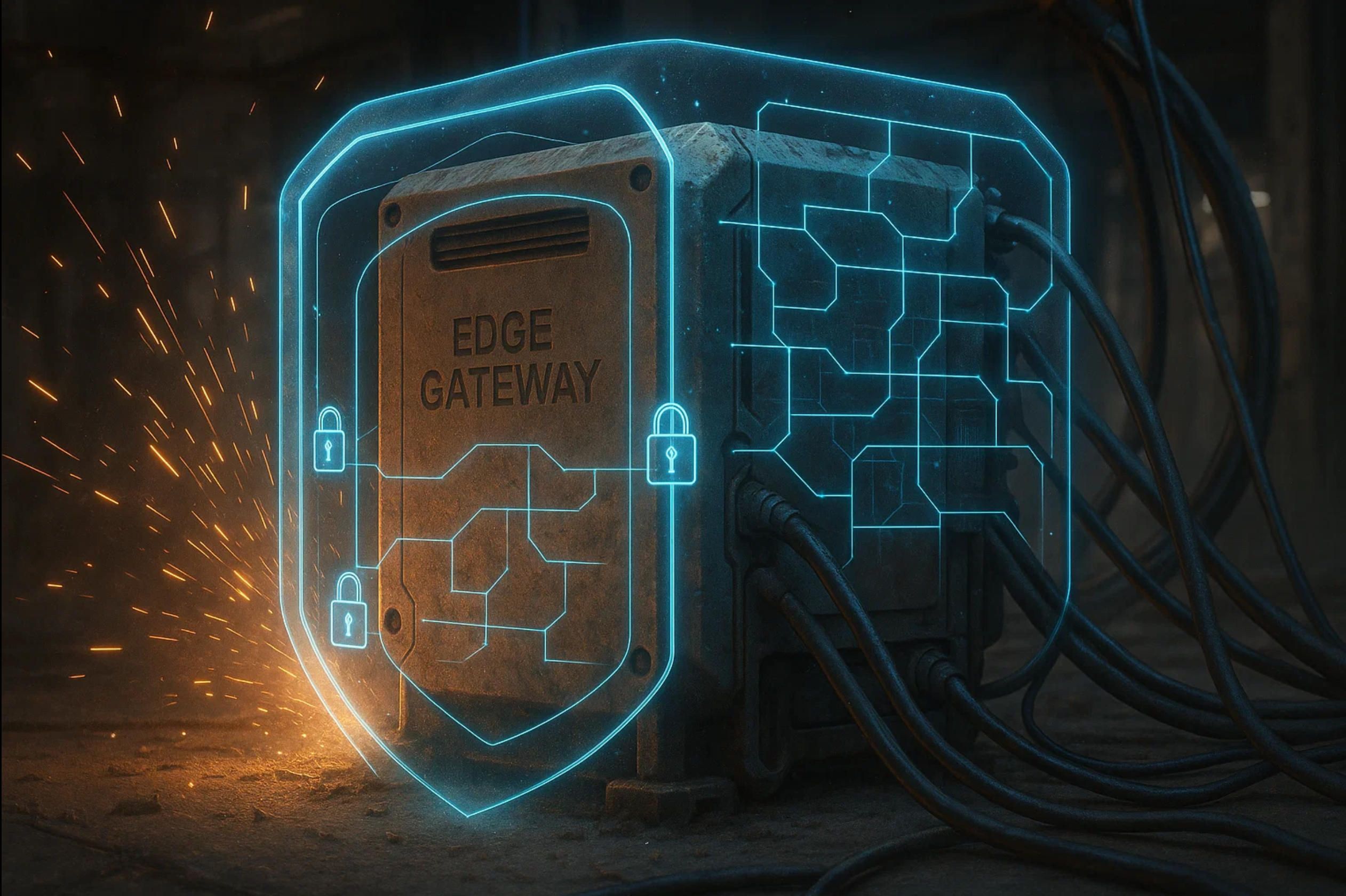
3.Securing the Harsh Edge: Cyber-Physical Threats, Compliance and Zero-Trust Architectures
Industrial plants want 99.999 % uptime, yet the same Ethernet drop that feeds a vibration sensor can shuttle ransomware straight into a turbine. When compute migrates from air-conditioned datacenters to oily shop floors, the attack surface follows. Because industrial IoT solutions now sit beside furnaces, conveyors and wells, protecting them is as critical as calibrating them. In 2025 more than half of global manufacturers raised OT security budgets specifically to defend industrial IoT solutions, recognising that a single compromised gateway can halt entire value streams. What follows shows how threats materialise at the edge, why regulatory pressure shapes every design decision, and how zero-trust blueprints turn fragile devices into self-defending industrial IoT solutions.
3.1 Threat Landscape and Physical Hazards
Legacy PLCs often expose unencrypted fieldbus frames. Once industrial IoT solutions bridge those frames to cloud dashboards, attackers gain a pivot between IT laptops and hydraulic presses. Phishing still opens many doors, but inside a plant the simplest breach is a rogue service laptop plugged into an unmanaged switch. Packet sniffers harvest Modbus registers in seconds, replay commands, then mask faults until bearings seize. In 2024 an automotive line lost forty-eight hours because malware riding a USB firmware update corrupted the protocol translator that powered its industrial IoT solutions.
Physical realities amplify the cyber risk. Dust fouls fanless heat sinks, vibration loosens RJ-45 latches, and −30 °C nights warp solder joints; each fault may reboot a sensor into an insecure default. Attackers know this and time probes for cold starts when industrial IoT solutions drop to maintenance mode. Even edge AI chips pose a risk: side-channel power analysis can leak model parameters, handing competitors the digital crown jewels. Because attackers mix network exploits with screwdriver sabotage, only holistic protection keeps industrial IoT solutions online.
First, we harden hardware. All A-Bots.com gateways ship with TPM 2.0 roots of trust, sealed enclosures rated IP67 and conformal coating to stop tin whiskers. Second, we quarantine protocols. Time-critical control messages stay on a deterministic VLAN; analytical bulk flows ride a separate QoS tier. If traffic strays across boundaries, industrial IoT solutions trigger automatic port isolation within tens of milliseconds. Third, we insist on signed firmware. A gateway refuses to boot images that lack a valid Ed25519 signature, blocking supply-chain implants long before they reach production. These measures convert vulnerable endpoints into rugged, trustworthy cornerstones for wider industrial IoT solutions.
3.2 Compliance-Driven Defense in Depth
Regulators treat a stalled pipeline or poisoned batch as a public-safety emergency, so industrial IoT solutions must satisfy both engineers and lawyers. The 2025 edition of IEC 62443 makes zone-and-conduit segmentation mandatory at skid level and enforces automatic credential rotation. NIST 800-82 Rev.3 extends similar mandates for North American facilities, requiring that industrial IoT solutions prove least-privilege access, vulnerability scanning and auditable change control. Meanwhile, the EU Cyber-Resilience Act threatens heavy fines for devices lacking coordinated disclosure programs.
A-Bots.com bakes compliance in from day one. During discovery we map every sensor, drive and role into IEC zones, tagging data flows by criticality. Each microservice in our industrial IoT solutions receives its own short-lived X.509 certificate minted by a cloud-agnostic vault; certificates refresh every four hours, so theft yields little value. Edge gateways propagate those identities downward, giving even a 1998 PLC the same cryptographic pedigree as a Kubernetes pod. Machine-readable manifests list software bills of materials, patch dates and hash proofs, forming an automatic evidence package when auditors arrive.
Compliance also pays dividends. Insurers now link premiums to objective maturity scores. Industrial IoT solutions that demonstrate automated patching and continuous monitoring can cut cyber-insurance costs by double digits, turning security spending into a financial positive. Moreover, procurement contracts increasingly demand proof that industrial IoT solutions align with ISO 27001 and SOC 2, so showing an end-to-end governance chain accelerates deal cycles. Instead of treating regulation as overhead, our clients wield compliant industrial IoT solutions as competitive leverage.
3.3 Zero-Trust by Design
Perimeter firewalls crumble the moment a contractor carries Wi-Fi into a paint booth. Zero trust replaces castle-and-moat assumptions with “never trust, always verify,” perfectly matching the heterogeneous, mobile nature of industrial IoT solutions. Implementation begins in silicon. On power-up every A-Bots.com gateway measures its firmware into the TPM, requests a time-bound certificate, and joins the network only if policy engines approve its identity, location and health score. Should a board swap break the attestation chain, the gateway fails closed, preventing counterfeit hardware from sneaking into industrial IoT solutions.
Micro-segmentation guards internal traffic. Lightweight agents enforce declarative rules: a vibration node may publish MQTT Topic /plant 1/line 3 but can never open SSH or browse the internet. If the sensor moves, the fingerprint changes, and policy denies until a technician re-authorises. This dynamic isolation lets industrial IoT solutions welcome guest devices during shutdowns yet lock them out once production resumes.
Observability ties everything together. eBPF probes inside edge kernels stream latency, packet-drop and anomaly metrics to a Grafana board; an unscheduled spike triggers a signed push to mobile HMIs within two hundred milliseconds. Operators can quarantine a misbehaving drive with a tap, and the command travels over mutually authenticated channels. Such human-machine collaboration turns zero-trust theory into daily practice and proves that properly instrumented industrial IoT solutions enhance safety instead of hindering throughput.
By integrating hardware roots of trust, automated compliance and zero-trust segmentation into the brutal realities of dust, heat and uptime, A-Bots.com converts fragile machinery into resilient, self-defending industrial IoT solutions. Forty-plus deployments across metals, food, energy and renewables confirm that security need not slow innovation; rather, it speeds rollout because every stakeholder—from auditors to plant electricians—trusts the technological foundation. If your roadmap includes scaling, modernising or rescuing industrial IoT solutions, begin with a security blueprint that respects the harsh edge, complies on day one and never assumes a safe perimeter. A-Bots.com is ready to build that blueprint with you and keep your industrial IoT solutions safe, compliant and future-proof.
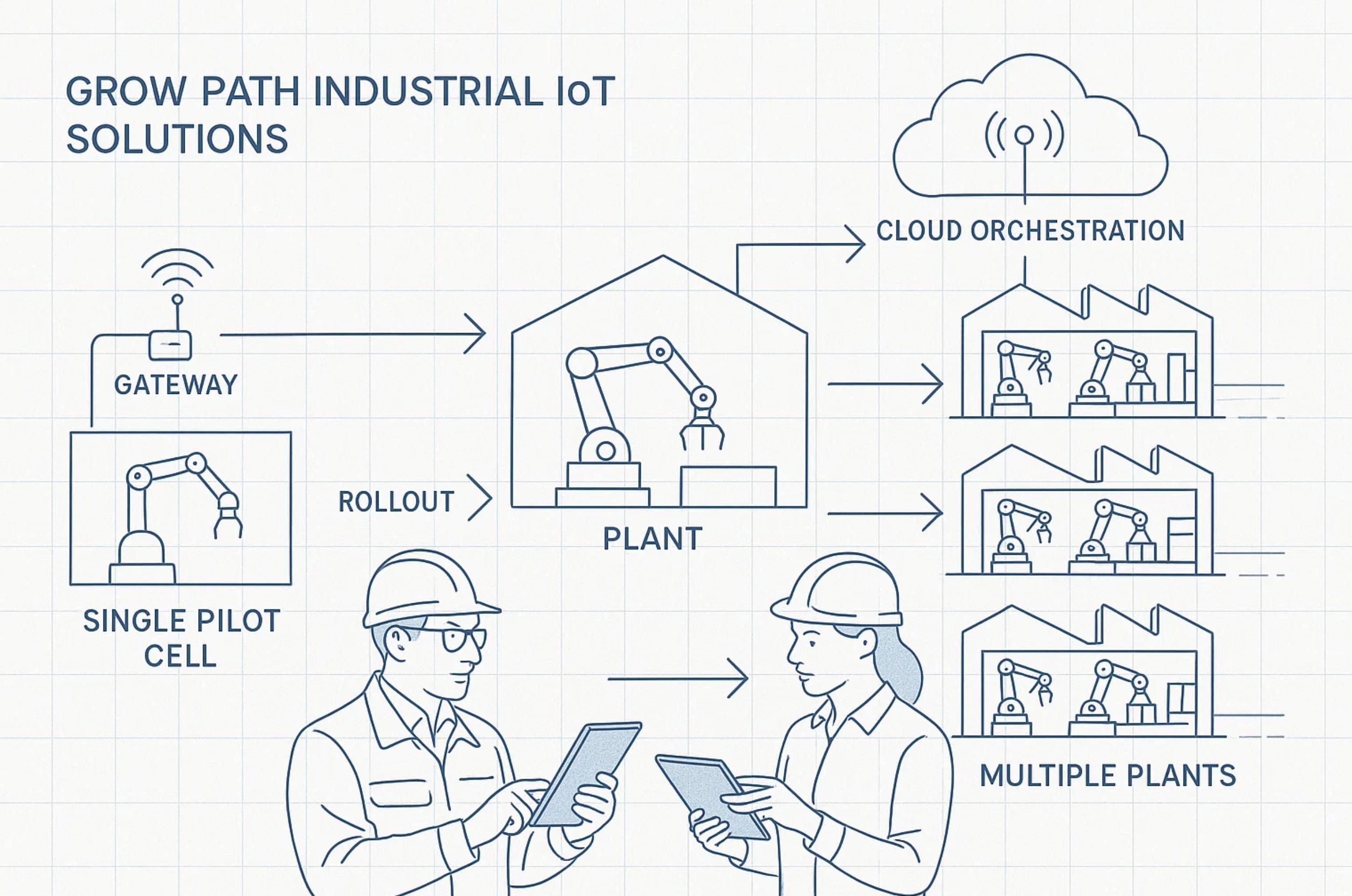
4.Build-to-Scale With A-Bots.com: Engagement Models, Tech Stack Choices and Go-Live Blueprint
Every factory, mine or utility that starts with a pilot eventually asks the same question: how do we multiply a single line-side proof-of-concept into plant-wide, multi-site industrial IoT solutions without drowning in technical debt or culture shock? A-Bots.com has answered that question more than forty times, for customers ranging from Kazakh metallurgists to North-American solar farms. The following blueprint condenses those lessons into three tightly coupled pillars. Each pillar is engineered so that industrial IoT solutions remain robust under dust, heat and executive scrutiny, yet evolve at cloud speed.
4.1 Engagement Models That De-Risk Scale
Successful industrial IoT solutions start with contractual clarity as much as with sensors. A-Bots.com offers three engagement tracks that map directly to client maturity. The first is Discovery Sprint: a two-week on-site immersion where our architects reverse-engineer data flows, tag bottlenecks and deliver a zero-assumption roadmap. Roughly forty percent of new industrial IoT solutions begin here because brown-field plants need hard evidence before green-lighting a pilot. The second track is Rapid Pilot: a six-week fixed-scope project that stands up a single edge gateway, a streaming backbone and a minimal operator app. This pilot generates live KPIs, letting stakeholders see industrial IoT solutions in action without betting the farm. The third track is Co-Delivery: a multi-quarter program where blended teams share backlog, code reviews and on-call duties. By the end of Co-Delivery, customers own the source, the skills and the confidence to extend industrial IoT solutions autonomously.
Payment terms mirror risk. Discovery Sprints are time-boxed and prepaid, giving leadership full cost visibility. Rapid Pilots split fees forty-sixty between kickoff and acceptance; success metrics include packet loss under burst, alert latency and operator adoption. Co-Delivery shifts to velocity-based billing, so investment tracks the steady march of industrial IoT solutions across new assets and plants. Throughout every model, intellectual-property clauses guarantee that clients retain engine-room knowledge; A-Bots.com merely licenses accelerators—tested firmware scaffolds, Grafana dashboards, Kubernetes Helm charts—that compress timelines by months. This balance keeps industrial IoT solutions vendor-neutral while still drawing on proven components.
4.2 Tech Stack Choices That Balance Longevity and Agility
Hardware at the edge may bolt to a wall for twenty years; cloud runtimes may evolve every quarter. Industrial IoT solutions thrive only when those tempos harmonize. A-Bots.com standardizes on ARM-based gateways with eight-year part warranties and TPM 2.0 chips, flashed with Yocto Linux to strip attack surface to the bone. Field protocols funnel through Sparkplug-B MQTT, because its Unified Namespace lets future teams graft new tags without rewriting schemas. For compute, we deploy K3s on the gateways; its lightweight binaries orchestrate containerized microservices yet tolerate dirty power and brownouts. This combination anchors industrial IoT solutions in hardware that survives vibration while still supporting blue-green updates.
On the backend, we favour a polyglot mesh. Apache Kafka channels time-critical streams, TimescaleDB warehouses historical metrics, and Grafana synthesizes dashboards. When latency budgets demand sub-second reflexes, we ship Apache Flink jobs to the gateway; when cross-site benchmarking demands petabyte muscle, we pipe the same topics into Snowflake or BigQuery. The golden rule is single message, multiple consumers: industrial IoT solutions should publish telemetry once and let specialized engines compete to extract value.
Mobile HMIs complete the loop. Flutter gives us one codebase for Android, iOS and upcoming vision-OS wearables, while gRPC plus protobuf keep payloads lean. Edge-cached offline mode means technicians still receive anomaly screenshots even when Wi-Fi is flaky—a non-negotiable trait for industrial IoT solutions deployed in remote quarries or metal sheds. Security inherits zero-trust defaults: mutual TLS everywhere, rotating certificates, and policy-as-code checked into Git so plant IT can audit every rule before industrial IoT solutions touch the network.
4.3 Go-Live Blueprint That Turns Pilots Into Fleet-Scale Reality
Scaling is a choreography: technical, operational, cultural. A-Bots.com stages industrial IoT solutions through five milestones. First, Pilot Cell: one gateway, one line, one operator shift. Success is measured by mean alert latency under two hundred milliseconds and zero unplanned downtime. Second, Expansion Slice: replicate the stack across an entire production line while integrating with MES for traceability. Third, Cross-Line Federation: unify topic namespaces so that quality models draw patterns across similar assets; at this point industrial IoT solutions usually start saving hard cash via predictive maintenance. Fourth, Multi-Site Rollout: deploy identical infrastructure-as-code to remote plants; CI/CD pipelines push firmware and container updates overnight, keeping industrial IoT solutions consistent across geographies. Fifth, Continuous Improvement Loop: embed a small site reliability squad that monitors eBPF metrics, budgets capacity and shepherds new analytics ideas from R&D to production in weeks.
Each milestone has a rollback plan. If an update causes edge CPU to spike beyond forty-percent headroom, Kubernetes automatically rolls back the pod, and industrial IoT solutions fall back to last-known-good logic. If a certificate authority fails, gateways default to fail-closed, ensuring no spoofed devices join. This battle-tested operational playbook keeps industrial IoT solutions resilient, even when unexpected sensor noise or corporate mergers change the landscape.
Training and governance travel with the code. Operators attend four-hour workshops that simulate real alarms; maintenance crews learn how to hot-swap a gateway without breaking cryptographic attestation. Quarterly tabletop exercises rehearse incident response; logs feed into SIEM systems so auditors can trace every action, proving that industrial IoT solutions not only meet, but document, compliance. Meanwhile, KPI dashboards track OEE deltas, energy cost per unit and carbon intensity, giving executives live ROI signals that justify continuous expansion of industrial IoT solutions across new plants and verticals.
In the end, scalability is not a line item; it is a culture. By coupling clear engagement models, future-proof tech stacks and a rigorous rollout cadence, A-Bots.com turns fragile prototypes into production-grade industrial IoT solutions that survive dust, heat and board meetings alike. Whether your roadmap calls for ten gateways or a thousand, the blueprint above ensures every deployment step compounds value instead of entropy, delivering industrial IoT solutions that are ready for tomorrow the moment they go live.
✅ Hashtags
#IndustrialIoTSolutions
#IIoT
#EdgeComputing
#ZeroTrust
#ABots
Other articles
Augmented-Reality Maintenance Apps for Cobots Industrial cobots are the future of automation, but servicing them efficiently remains a challenge. This article explores how Augmented-Reality maintenance apps, powered by IoT and AI integration, dramatically reduce downtime, costs, and errors. Discover real-world case studies, data-driven insights, and why partnering with A-Bots.com can future-proof your maintenance operations with cutting-edge AR solutions.
Aerial Photography Mapping Software The article dissects a full-stack journey from flight data capture to enterprise roll-out of an aerial mapping platform. Readers learn why sensor stacks and RTK/PPK workflows matter, how AI boosts SfM and MVS speed, and what Kubernetes-driven GPU architecture keeps terabytes of imagery flowing on schedule. Real-world benchmarks, ISO-aligned security controls and an 18-week go-live roadmap show decision-makers exactly how A-Bots.com transforms proof-of-concept scripts into production-grade geospatial intelligence—with zero vendor lock-in and measurable carbon savings.
Robot Vacuum Cleaner App Development Company | Custom Ecosystems by A-Bots.com What separates a premium robot vacuum from yet another puck of plastic is not suction power but software finesse. This in-depth article traces every layer of that finesse—from centimetre-scale SLAM and real-time MQTT telemetry to zero-downtime OTA pipelines and multi-home UX. Featuring the Shark Clean case study, it details how A-Bots.com scaled a million-device fleet while keeping sub-150 ms command latency worldwide. You will learn concrete engagement models, a compliance-by-design checklist, and a future-proof roadmap that turns firmware, cloud and mobile into one cohesive organism. Whether you are an OEM seeking a catalyst sprint or a brand ready for full turnkey delivery, the blueprint inside shows how to convert autonomous cleaning into durable competitive advantage.
Sensor-Fusion eBike App Development Company Looking to leapfrog the competition with a data-driven eBike? A-Bots.com is the specialist app development company that fuses strain-gauge torque, dual-band GNSS and UWB security into a seamless mobile experience. From adaptive pedal-assist curves and crash detection to predictive battery RUL dashboards, our end-to-end stack—bike ECU, Kotlin / Swift apps and AWS serverless back-end—turns raw telemetry into rider delight and recurring revenue. Partner with a single-SLA team that prototypes in weeks, scales to global fleets and safeguards compliance in every jurisdiction.
Explore DoorDash and Wing’s drone delivery DoorDash and Wing are quietly rewriting last-mile economics with 400 000+ aerial drops and 99% on-time metrics. This deep dive maps milestones, performance data, risk controls and expansion strategy—then explains how A-Bots.com turns those insights into a fully-featured drone-delivery app for your brand.
Top stories
Copyright © Alpha Systems LTD All rights reserved.
Made with ❤️ by A-BOTS
